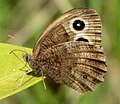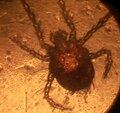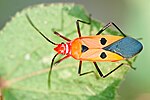In biology, a nymph (from Ancient Greek νύμφα nūmphē meaning "bride") is the juvenile form of some invertebrates, particularly insects, which undergoes...
6 KB (545 words) - 09:52, 25 June 2024
Greek mythology, a nymph or nymphe (Ancient Greek: νύμφη) is a female nature-spirit. Nymph or nymphe may also mean: Nymph (biology), the immature form...
2 KB (301 words) - 06:14, 30 October 2023
Dragonfly (redirect from Dragonfly nymph)
dragonfly nymphs". Journal of Comparative Physiology A. 97 (4): 329–338. doi:10.1007/BF00631969. S2CID 45066664. Corbet, Philip S. (1980). "Biology of odonata"...
85 KB (9,510 words) - 03:08, 9 October 2024
Marine biology is the scientific study of the biology of marine life, organisms that inhabit the sea. Given that in biology many phyla, families and genera...
42 KB (4,587 words) - 19:36, 20 October 2024
Hydra (genus) (redirect from Hydra (biology))
the lake or pond to await better conditions, whereupon they hatch into nymph Hydra. Some Hydra species, like Hydra circumcincta and Hydra viridissima...
29 KB (3,315 words) - 19:28, 20 October 2024
Metamorphosis (redirect from Metamorphosis (biology))
Experiments on firebugs have shown how juvenile hormone can affect the number of nymph instar stages in hemimetabolous insects. In chordates, metamorphosis is...
23 KB (2,677 words) - 13:46, 3 July 2024
Head louse (section Development and nymphs)
operculum allows the embryo to breathe. A first-stage nymph hatching from an egg A first-stage nymph hatching from an egg (detail) Empty shells are matte...
34 KB (3,705 words) - 12:36, 18 September 2024
larvae are often eaten by other invertebrates, such as damselfly naiads/Nymph (biology), and fish. In North America, it is noted that this species is a natural...
3 KB (216 words) - 06:28, 7 September 2023
Regeneration in biology is the process of renewal, restoration, and tissue growth that makes genomes, cells, organisms, and ecosystems resilient to natural...
83 KB (9,303 words) - 05:58, 24 September 2024
clothing until the next blood-meal. The nymph will molt three times before the adult louse emerges. The nymph usually takes 9–12 days to develop into...
17 KB (1,617 words) - 18:06, 26 July 2024
common wood-nymph (Cercyonis pegala) is a North American species of butterfly in the family Nymphalidae. It is also known as the wood-nymph, grayling,...
10 KB (1,030 words) - 19:31, 24 August 2024
Trombiculidae (section Nymph)
hue. There is a marked constriction in the front part of the body in the nymph and adult stages. The best known species of chigger in North America is...
23 KB (2,496 words) - 19:31, 26 September 2024
Phylum (redirect from Phylum (biology))
In biology, a phylum (/ˈfaɪləm/; pl.: phyla) is a level of classification or taxonomic rank below kingdom and above class. Traditionally, in botany the...
59 KB (4,166 words) - 17:52, 18 October 2024
which hatch in three to 10 days, move about on the skin, moult into a nymphal stage, and then mature into adult mites. The adult mites live three to...
9 KB (1,214 words) - 22:45, 1 October 2024
Naiad (disambiguation) (redirect from Naiad (biology))
The Naiads are water-centered nymphs in Greek mythology. Naiad may also refer to: Naiad (character), the water elemental of the DC Universe Naiad Press...
1 KB (154 words) - 17:30, 14 December 2023
of the spotted lanternfly are characterized by spotted black and white nymphs that develop a red pigmentation and wings as they mature. Early life instars...
83 KB (7,719 words) - 22:57, 18 October 2024
larvae are normally orange or red with six legs, but develop eight legs by nymph stage. The larvae are up to 0.2 mm (0.01 in) in size, with adult mites about...
2 KB (187 words) - 23:01, 1 October 2024
Pennsylvania, where it is believed to have been accidentally introduced. The nymphs and adults of the brown marmorated stink bug feed on over 100 species of...
57 KB (5,854 words) - 14:10, 1 October 2024
Cercopoidea (section Spittlebug nymphs)
families are best known for the nymphal stage, which produces a cover of foamed-up plant sap visually resembling saliva; the nymphs are therefore commonly known...
10 KB (1,006 words) - 15:26, 7 October 2024
Moulting (redirect from Shedding (biology))
In biology, moulting (British English), or molting (American English), also known as sloughing, shedding, or in many invertebrates, ecdysis, is a process...
20 KB (1,818 words) - 08:13, 20 October 2024
Dysdercus cingulatus (section Biology)
cotton stainer. It is a serious pest of cotton crops, the adults and older nymphs feeding on the emerging bolls and the cotton seeds as they mature, transmitting...
5 KB (518 words) - 16:48, 28 May 2024
Psocoptera (section Anatomy and biology)
that may eat psocids. The nymph of a psocid species, Psilopsocus mimulus, is the first known wood-boring psocopteran. These nymphs make their own burrows...
13 KB (1,376 words) - 02:25, 27 September 2024
from its host, molts into a nymph when on the ground, and quests by crawling on the ground or waiting on vegetation. The nymph feeds and repeats the same...
18 KB (2,190 words) - 22:43, 1 October 2024
Trombidium holosericeum (section Biology)
without severely harming the host. These larvae then develop into free-living nymphs that resemble adults. Mąkol, J.; Wohltmann, Andreas (2000). "A redescription...
3 KB (272 words) - 22:45, 1 October 2024
erstwhile Sea Nymph were questioned about many aspects of their story. Experts in sailing, meteorology, Hawaiian seamanship, and marine biology, as well as...
23 KB (2,248 words) - 18:51, 14 September 2024
Imago (category Insect developmental biology)
metamorphosis is "incomplete", the final ecdysis follows the last immature or nymphal stage. In members of the Holometabola, in which there is a pupal stage...
3 KB (352 words) - 12:40, 26 September 2024
Oxycarenus lavaterae (section Biology)
a little longer. The nymphs can be easily recognized by their black head and the red-colored abdomen. The wing pads of the nymphs are completely black...
4 KB (327 words) - 03:27, 18 July 2023


























